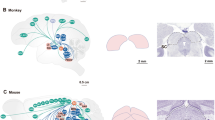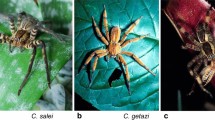Summary
Serotonin-immunoreactivity is mapped in wholemounts and slices of the suboesophageal ganglion (SOG) of larval Manduca sexta by means of immunocytochemistry. An extensive meshwork of serotonin-immunoreactive nerve fibres on some peripheral nerves of the SOG has been demonstrated. This meshwork appears to belong to a serotonergic neurohemal system, probably supplied by two pairs of bilateral serotonin-immunoreactive neurons with big cell bodies on the dorsal side near the midline in the mandibular neuromere. Intracellular recording and staining revealed their physiology and morphology. These neurons produce long lasting (50 msec) action potentials, which suggest that they are neurosecretory cells. Two pairs of bilateral serotonin-immunoreactive interneurons similar to those of other insects are stained in the labial and maxillar neuromeres, but not in the mandibular neuromere. Their ventrolaterally located cell bodies project through a ventral commissure into the contralateral hemiganglion and then cross back again through a dorsal commissure. The axons project into the contralateral circumoesophageal connective.
Similar content being viewed by others
References
Baines RA (1988) Role of 5-hydroxytryptamin and peptides in the innervation of locust salivary glands and mandibular muscles. PhD thesis, University of Manchester
Baines RA, Tyrer MN (1989) The innervation of locust mandibular muscles: Serotonergic and peptidergic modulation of skeletal muscle. J Comp Physiol (to appear)
Bell RA, Joachim FA (1976) Techniques for rearing laboratory colonies of the tobacco hornworms and pink bollworms. Ann Entomol Soc Am 69:365–373
Berridge MJ, Patel NG (1968) Insect salivary glands: Stimulation of fluid secretion by 5-hydroxytryptamine and adenosine-3′,5′-monophosphate. Science 162:462–463
Bishop CA, O'Shea M (1983) Serotonin immunoreactive neurons in the central nervous system of an insect (Periplaneta americana). J Neurobiol 14:251–269
Bowser-Riley F, House CR (1976) The actions of some putative neurotransmitters on the cockroach salivary gland. J Exp Biol 64:665–676
Bräunig P (1987) The satellite nervous system — an extensive neurohemal network in the locust head. J Comp Physiol [A] 160:69–77
Bräunig P (1988) Neurosecretory cells of the locust suboesophageal ganglion. Symp Biol Hung 36:161–171
Brogan RT, Pitman RM (1981) Axonal regeneration in an identified insect motorneurone. J Physiol (Lond) 319:49–58
Brown BE (1967) Neuromuscular transmitter substance in insect visceral muscle. Science 155:595–597
Collins C, Miller T (1977) Studies on the action of biogenic amines on cockroach heart. J Exp Biol 67:1–15
Cook BJ, Eraker J, Anderson GR (1969) The effect of various biogenic amines on the activity of the foregut of the cockroach, Blaberus giganteus. J Insect Physiol 15:445–455
Davis NT (1985) Serotonin-immunoreactive nerves and neurohemal system in the cockroach Periplaneta americana (L.). Cell Tissue Res 240:593–600
Davis NT (1987) Neurosecretory neurons and their projections to the serotonin neurohemal system of the cockroach Periplaneta americana (L.) and identification of mandibular and maxillary motor neurons associated with this system. J Comp Neurol 259:604–621
Flanagan TRJ (1984) Cytological evidence for serotonin-containing fibers in an abdominal neurohemal organ in a hemipteran. Brain Res 306:235–242
Freeman MA (1966) The effects of drugs on the alimentary canal of the African migratory locust, Locusta migratoria. Comp Biochem Physiol 17:755–764
Griss C (1988) Morphology and physiology of the mandibular motorneurons in Manduca sexta. In: Elsner N, Barth FG (eds) Sense organs: interfaces between environment and behavior (Proc. 16th Göttingen neurobiol conf) Thieme Verlag Stuttgart New York, p 297
Homberg U, Hildebrand JG (1987) Serotonin-immunoreactivity in the brain of the sphinx moth Manduca sexta. In: Elsner N, Creutzfeldt O (eds) New frontiers in brain research (Proc 15th Göttingen neurobiol conf) Thieme Verlag Stuttgart New York, p 256
Homberg U, Hildebrand JG (1989) Serotonin-immunoreactive neurons in the median protocerebrum and suboesophageal ganglion of the sphinx moth Manduca sexta. Cell Tissue Res 258:1–24
House CR, Smith RK (1978) On the receptors involved in the nervous control of salivary secretion by Nauphoeta einera Olivier. J Physiol (Lond) 279:457–471
Johnson GD, de C Nogueira Araujo GM (1981) A simple method of reducing the fading of immunofluorescence during microscopy. J Immunol Methods 43:349–350
Maddrell SHP, Phillips JE (1975) Secretion of hypo-osmotic fluid by the lower Malpighian tubulus of Rhodnius prolixus. J Exp Biol 62:671–673
Maddrell SHP, Picher DEM, Gardiner BOC (1971) Pharmacology of the Malphighian tubules of Rhodnius and Carausius: The structure-activity relationship of tryptamine analogues and the role of cycle AMP. J Exp Biol 62:671–673
McFarlane JE (1967) Aging in an adult insect heart. Can J Zool 45:1073–1081
Nässel DR (1988) Serotonin and serotonin-immunoreactive neurons in the nervous system of insects. Prog Neurobiol 30:1–85
Nässel DR, Cantera R (1985) Mapping of serotonin-immunoreactive neurons in the larval nervous system of the flies Calliphora erythrocephala and Sacrophaga bullata. Cell Tissue Res. 239:423–434
Nässel DR, Elekes K (1985) Serotonergic terminals in the neural sheath of the blowfly nervous system: Electron microscopical immunocytochemistry and 7-dihydroxytryptamine labelling. Neuroscience 15:293–307
Nicholson SW, Millar RP (1983) Effects of biogenic amines and hormones on butterfly Malphighian tubules: Dopamine stimulates fluid secretion. J Insect Physiol 29:611–615
Orchard I, Lange AB, Barrett FM (1988) The release of serotonin from the peripheral nervous system of the blood feeding insect, Rhodnius prolixus Stål, in response to feeding. Soc Neurosci [Abstr] 14:155.19
Radwan WA, Lauder JM, Granger NA (1989) Development and distribution of serotonin in the central nervous system of Manduca sexta during embryogenesis II. The ventral ganglia. Int J Neurosci 7:43–53
Rehder V, Bicker G, Hammer GM (1987) Serotonin-immunoreactive neurons in the antennal lobes and suboesophageal ganglion of the honeybee. Cell Tissue Res 247:59–66
Spörhase-Eichmann U, Schürmann F (1988) Serotonin-immunoreactivity in the central nervous system of the cricket Gryllus bimaculatus. In: Elsner N, Barth FG (eds) Sense organs: interfaces between environment and behaviour (PSroc 16th Göttingen neurobiol conf) Thieme Verlag, Stuttgart New York, p 298
Stewart WW (1978) Functional connections between cells as revealed by dye-coupling with a highly fluorescent naphthalimide tracer. Cell 14:741–759
Taghert PH, Goodman CS (1984) Cell determination and differentiation of identified serotonin-immunoreactive neurons in the grasshopper embryo. J Neurosci 4:989–1000
Trimmer BA (1985) Serotonin and the control of salivation in the blowfly Calliphora. J Exp Biol 114:307–328
Tublitz NJ, Truman JW (1985) Insect cardioactive peptides. II. Neurohormonal control of heart activity by two cardioacceleratory peptides in the tobacco hawkmoth, Manduca sexta. J Exp Biol 114:381–395
Tyrer NM, Turner JD, Altman JS (1984) Identifiable neurons in the locust central nervous system that react with antibodies to serotonin. J Comp Neurol 227:313–330
Valles AM, White K (1988) Serotonin-containing neurons in Drosophila melanogaster: Development and distribution. J Comp Neurol 268:414–428
Whitehead AT (1973) Innervation of the American cockroach salivary gland: Neurophysiological and pharmalogical investigations. J Insect Physiol 19:1961–1970
Author information
Authors and Affiliations
Rights and permissions
About this article
Cite this article
Griss, C. Serotonin-immunoreactive neurons in the suboesophageal ganglion of the caterpillar of the hawk moth Manduca sexta . Cell Tissue Res. 258, 101–109 (1989). https://doi.org/10.1007/BF00223149
Accepted:
Issue Date:
DOI: https://doi.org/10.1007/BF00223149




